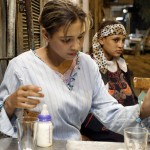On Friday afternoon I met Girish for a screening of These Girls, Tahani Rached’s documentary about a small community of Egyptian teenagers who live on the streets of Paris. They survive on discarded food and pass their days sniffing glue, taking pills, avoiding arrest, fighting, and raising the small children who are only a few years younger than they themselves. Rached focuses most of her attention on four or five young girls, each of whom is trapped both by poverty and by the Islamic laws and customs that leave women at the mercy of men. Abused by their fathers, they turn to the streets where they’re abused again by the packs of homeless boys. One girl already has two children, another is pregnant, and several have been deliberately scarred with slashes across their cheeks.
These Girls is a difficult film to watch. Rached avoids over-sentimentalizing her subject, and, frankly, the girls have been hardened to the point that, at times, I found it difficult to muster the appropriate sympathy for them. (I say that with embarrassment.) I had to leave twenty minutes before the film ended, so I’ll hold off on any kind of final evaluation. These Girls has been selected for the New York Film Festival and, if properly marketed, has the potential to find the same audience that went to see Born into Brothels.
I scheduled These Girls mostly because it was paired with Toy, Waguih, a short essay film in which the filmmaker, Namir Abdel Messeeh, interviews his father, who forty years earlier had been arrested in Egypt for his activities with communist resistance movements. After five years in prison, he broke ties with his Leftist past, emigrated with his wife to France, and once there raised his family into a respectable, white collar world. At a retirement party, Messeeh’s father is applauded for his decades of quiet devotion to the job, and it’s clearly that dichotomy that so fascinates (and, perhaps, frustrates) his son. How could a political militant who survived torture and forced marches through the Sahara abandon his “principles” for a life of capitalist comfort? And how could he remain silent about the issue for so many years, not telling even his own son the details of his past life?
I know too little about Egypt’s history to even attempt an analysis of Messeeh’s film, but it’s the kind of political movie I like best: a meditation on memory and on the waves of personal consequence that ripple through history. It’s what cinema can do that a written essay can’t. There’s something in the aesthetic experience of witnessing Messeeh’s father’s furrowed brow and pronounced lower lip (his son has the exact same lip) that encapsulates the ambivalences and dichotomies of his experience. Toy, Waguih isn’t Night and Fog, but it’s a deceptively complex and urgent piece. I liked it quite a lot.
Already, I’m enjoying the heavy concentration of avant-garde films that I’ve scheduled this year, but I’m at a loss as to how I should go about blogging them. For now, I’ll stick to those pieces that impressed me in a way I feel capable of describing.
Wavelengths 1 ended with Un Pont sur la Drina by Xavier Lukomski, which consists of five or six long (long in terms of both distance and time) static shots of the bridge that spans the Drina river in Višegrad. The film opens and closes with lines from Ivo Andric’s novel The Bridge on the Drina, lines that note the location’s national importance as a site of conflict. The film’s soundtrack is a mix of diegetic sound (wind, distant voices, occasional hints of traffic) and recorded testimony from a war crimes trial in which a young man describes the long nights he and his neighbors spent pulling out, searching, and burying the hundreds of mutilated bodies that floated under the bridge from battles upstream.
Two days and six film programs later, I find myself thinking often of Un Pont sur la Drina. In one sense it’s a film about that uncanny experience we’ve all had as we’ve crossed into the Tower of London or walked across the battlefields of Gettysburg or viewed the shorelines near Normandy — the sense that we’ve stumbled upon a site that is simultaneously past and present. Lukomski’s long takes, which on one level are fairly innocuous landscape portraits, become haunted in some way. Again, unfortunately, I know too little about the history of the Balkans to risk specific analysis. I was, however, struck by the testimony itself, which is translated to French in the soundtrack (so that we hear the man’s actual voice for only a few seconds when he begins each new statement) and then translated again to English in the subtitles. That in itself is an interesting commentary, I think, on the impact of globalization on national identity, an idea I’ll likely return to in my next post, when I discuss Sissako’s Bamako.
